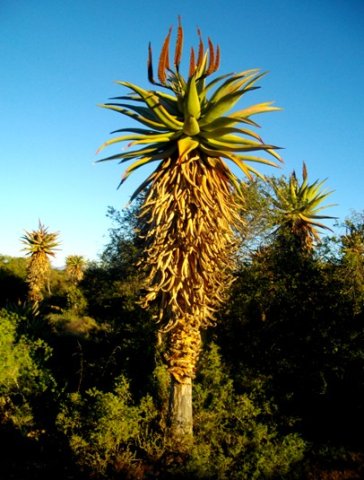Aloe ferox

Author: Ivan Lätti
Photographer: Thabo Maphisa
The Aloe ferox specific name of ferox meaning fierce or warlike in Latin was bestowed in recognition of the warning contained in the unyielding brownish red teeth on the leaf margins, as well as spines on both surfaces of the leaf blades of some specimens. Most plants reach heights of 2 m to 3 m, rarely above 5 m. There may be 50 to 60 leaves per rosette, a leaf being up to 1 m in length and 15 cm wide at the base (SA Tree List No. 29.2).
Leaf colour is dull green, sometimes with a reddish tinge. The leaf curvature may be S-shaped as here: close to the base there is an upwards curve and a second downwards one nearer the tip. Southern Cape plants like these, however, often only show the single, lower curve that goes upwards. The KwaZulu-Natal form that used to be known as A. candelabrum is more likely to have full S-curve leaves.
Tall stems may have a smooth section at the base where leaf remains had naturally dropped off over time completely.
The species distribution is in the Western Cape eastwards of Swellendam, widespread across the Eastern Cape into KwaZulu-Natal as far as Pietermaritzburg and slightly into the southeast Free State; also in Lesotho. The photo was taken in the Rooiberg.
The habitat is very diverse, including succulent Karoo, fynbos, Albany thicket and grassland. The species is not considered to be threatened in its various habitats early in the twenty first century in spite of impact from harvesting for the medicine and cosmetic trade, farming, habitat loss and veld mismanagement (Coates Palgrave, 2002; Reynolds, 1974; http://redlist.sanbi.org).

